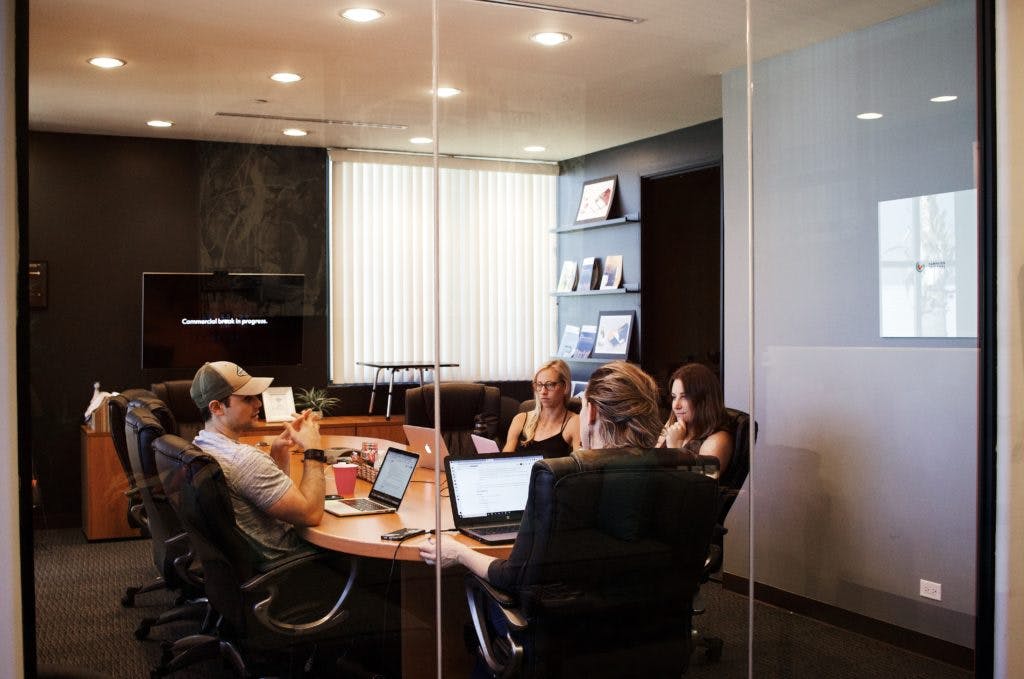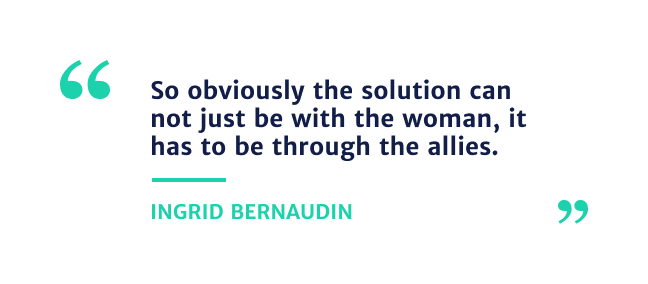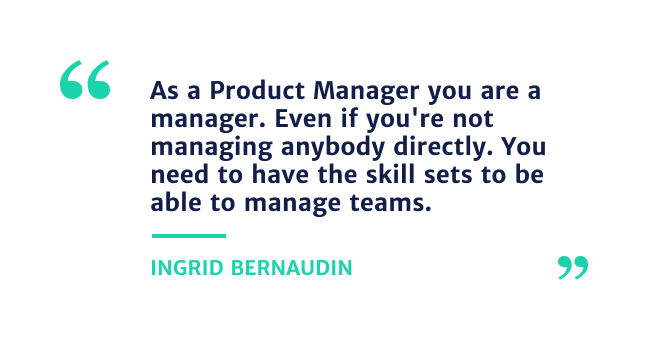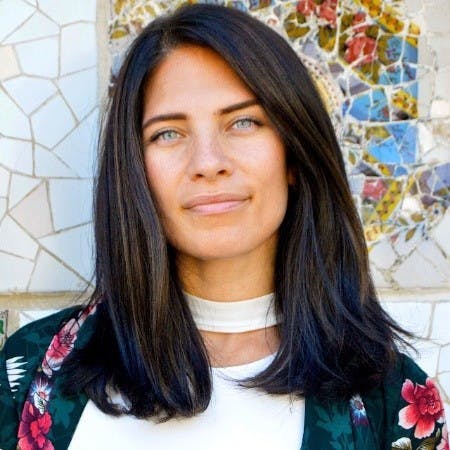Season 4 - Episode 6
Intuition and Product Creation
Ingrid Bernaudin is the Director of Product at Uber, a tech company that offers transportation services, food delivery, and package delivery. She walks us through her Product journey, problem solving at Uber, how to increase diversity in the workplace, and more.

“Question [00:00:56] Why don’t you tell us a more about how you got started in product? ”
Ingrid [00:01:01] Sure. All right. So a little bit about me as you guessed first was the name and then with the accent, um, I’m French. So born and raised in France in Bordeaux. Exactly. I started a master’s degree in computer science, so the first 10 years of my career, I was in engineering and went into engineering, development, architect, and then engineering manager. I worked in the innovation and the first time to market products. I’m going to age myself, I worked on the predictive analysis before anybody knew what it was, and before it was cool. So I had a big input in data and business intelligence and did that for 10 years. Then I moved to Japan to work with our very demanding Japanese customers. I burst into my engineering bubble. I was like, what are people doing with our products? Why would they do these? Why are they using it that way? It all of a sudden made me think about the product in general. Where are we going with it? What’s the vision, what’s the strategy? Why are we doing these features versus those feature? And so that’s how I became interested in the product.
Then I moved to Vancouver after Japan and there, I created a team of engineers for business subjects. I still had this idea of working on the product and that’s when I started in product management. So I started in very technical products with some cloud products that we’re integrating with on-premise products in a timeline. It wasn’t that easy. Then I moved to more mobile products and love the mobile experience, not creating a mobile application. That’s when I engaged in waste product management.
Then B2B, B2C, I went to Shutterfly for B2C, created a model of work on around photos and loved it, saw how we can engage people’s where their photos and how we can auto-generate products using a lot of AI and ML. That was super exciting. And then after that, after three years at Shutterfly, I moved to Uber because I got excited about the driver team. I keep on saying to my friends and family and network that you’ve been beating on the sideline and not be happy about what Uber is doing, it’s a very controversial company or you can go in and try to change things and do the best for our drivers. So that’s where I am the driver team at Uber. I’m working on providing income from millions of people around the world and really interesting problems to solve.

“Question [00:04:16] Where are some of those big challenges that you are passionate about solving? ”
Ingrid [00:04:21] There are a bunch of them. The first one, so I was in driver growth. So how do we bring drivers into our platform? How do we retain them? How to get them back when they’re turning? One of the big thing for me was, that there is very few women driver around the world, for very different reasons. Some for safety concerns, some are due to social norms and politics that are in place in different countries. One of the things that I was trying to do was how can we bring in more women? Because one of the things that we’ve seen especially when we’re doing a round table with women driver, we realized that driving is a great work for women that need a lot of flexibility, especially single moms, or women that needs to take care of other elder people, that have very strict schedules, or they usually care for their community. So they need a lot of flexibility. They can not do the nine to five, but they also need their independence. It always goes through having some money so you need financial independence before you can have social independence.
That’s something that we’re working a lot on. How is our product? How is the product in terms of diversity? Is it good for women? Is it not good for a woman? What are the things that we can do to improve it? Then of course it’s all about drivers and how can we make it easy for them to come to the platform. Uber has a crazy funnel. I think everybody’s thinking about the funnel, they think about those three steps that you need to do to sign up, you need to do your name and put information, your email, and password, and you’re done. At Uber, our funnel has over seven sides of each iteration. It spans around the world with all the different types of approvals and regulations that you have. It goes from asking you for two documents and it takes about five minutes to France, for an example of complexity, you can ask for about 57 documents and you can take a year and a half and costs several thousand Euros.
Those are all the great things about the product. How do you make it work? How do you make it work so that it’s flexible? But also it’s working well and the team doesn’t have to think about all those crazy flexibility and it’s working with only one framework. Then you add those, not just drivers, we’re also working with countries and we’re working with the food drivers and the restaurants. So you imagine the kind of system that we’re working on and it’s awesome.

“Question [00:10:11] As a man, how can make you make ourselves allies and contribute to increasing the diversity numbers? ”
Ingrid [00:10:12] That’s a great question. It’s especially important when you have such a difference in numbers. So obviously the solution can not just be with the woman, it has to be through the allies. A lot of times when we talk to men, they don’t know what they can do, like you were saying. So they are a few things that you can do that are very easy to do, which would avoid a lot of gender bias that is happening constantly. So one of the big things, for example, is calling it out. So if you’re in a meeting and you see someone that seems to interrupt when a woman is talking or when a woman gave a solution or an idea, and then it’s repeated by your male counterpart a few minutes later, call it out, say, “Hey, great, I love your passion, but can we please let in Ingrid finish” or, “that’s a great idea and Ingrid said it just before, so how can we make this happen?” So being able to call out when these things are happening, is a great thing to do.

I think another super important thing is to mentor women in their surroundings. So there, you always have women around you. Mentoring is a great way to increase woman visibility, but bigger than mentoring, sponsoring is what women need. Then, the difference between mentor and sponsor, for one who doesn’t know, is that mentoring is going to be there for us to answer some of the questions that would be great to educate you, grow you like a coach. But then sponsoring will be, you will be there for this person and you will make sure that when there are interesting projects she will be there to make sure she can have more visibility. You will provide this possibility. So if you’re a male in the room, think about it. Are you sponsoring any women in your company? Are you mentoring any woman company? And how can you do these two to increase visibility?
Then I would just say one more, which is very funny because people don’t realize, is to share the non-promotable workload and opportunities. This one is super important to you as you’re going to notice what I’m going to tell you. It’s not as open through zoom now that we’re in COVID and shelter in place and all this, but when you’re in the room, a lot of the time the woman is doing the non promotable work, which is she’s going to take the notes, she is going to go and grab the coffee, she’s going to go and organize the birthday party, she is going to go and organize the next happy hour, she’s going to do all those things that are the social work. This is great, but it takes a lot of work and that means that you’re not doing the work that you need to do to get promoted.
You might also be interested in: Innovation, Inclusivity, and Women in Product

“Question [00:27:01] What do you think about those types of career paths for the product? ”
Ingrid [00:27:05] This is a that’s a really good question. It’s interesting because the way I see it, I think there is a difference between engineering and product management. For me, the biggest difference is that as a Product Manager you are a manager. Even if you’re not managing anybody directly. You need to have the skill sets to be able to manage teams because you rely on so many teams to do what you want them to do. You know, basically by defact managing that engineering team and the design team and other teams, if your company uses other types of individuals. So I think from a Product Manager, the people management part should come more easily to you than for Engineers. Engineering is a completely different skillset.

But that said, I think that’s one of the things that we’re seeing is that even though you have this skill set that might not be what you want to do, as you were saying, it might not be what you’re interested in doing. You don’t want to do the performance reviewing risking spots, you don’t want to spend time talking to people, especially people that need to be leveled. So all those despicable conversations, you, you might not like it. So that’s something that we’re working at Uber. Just this year, we increase the pass of single contributors just for this, because I think there is a very good way for people that are becoming real experts in a domain and provide a lot of value to the product, to still be, in a single contributor pass. So that it doesn’t mean that you need to become a manager to grow as a leader in the company.
So I’m super happy to see that happening in many companies, we see it happening in all the big companies and the small companies are going that route as well. So I think it’s, it’s great for Product Management and for all the Product Managers that don’t want to go through the engineering paths, sort of the management.
You might also be interesteed in: 3 Reasons Why Software Engineers Make Great Product Managers
We’ll be back next week with Christine Itwaru from Pendo with even more of the latest insights from the Product Management world.
Listen to our episodes on your favorite platform
Stay tuned for new episodes
By sharing your email, you agree to our Privacy Policy and Terms of Service






